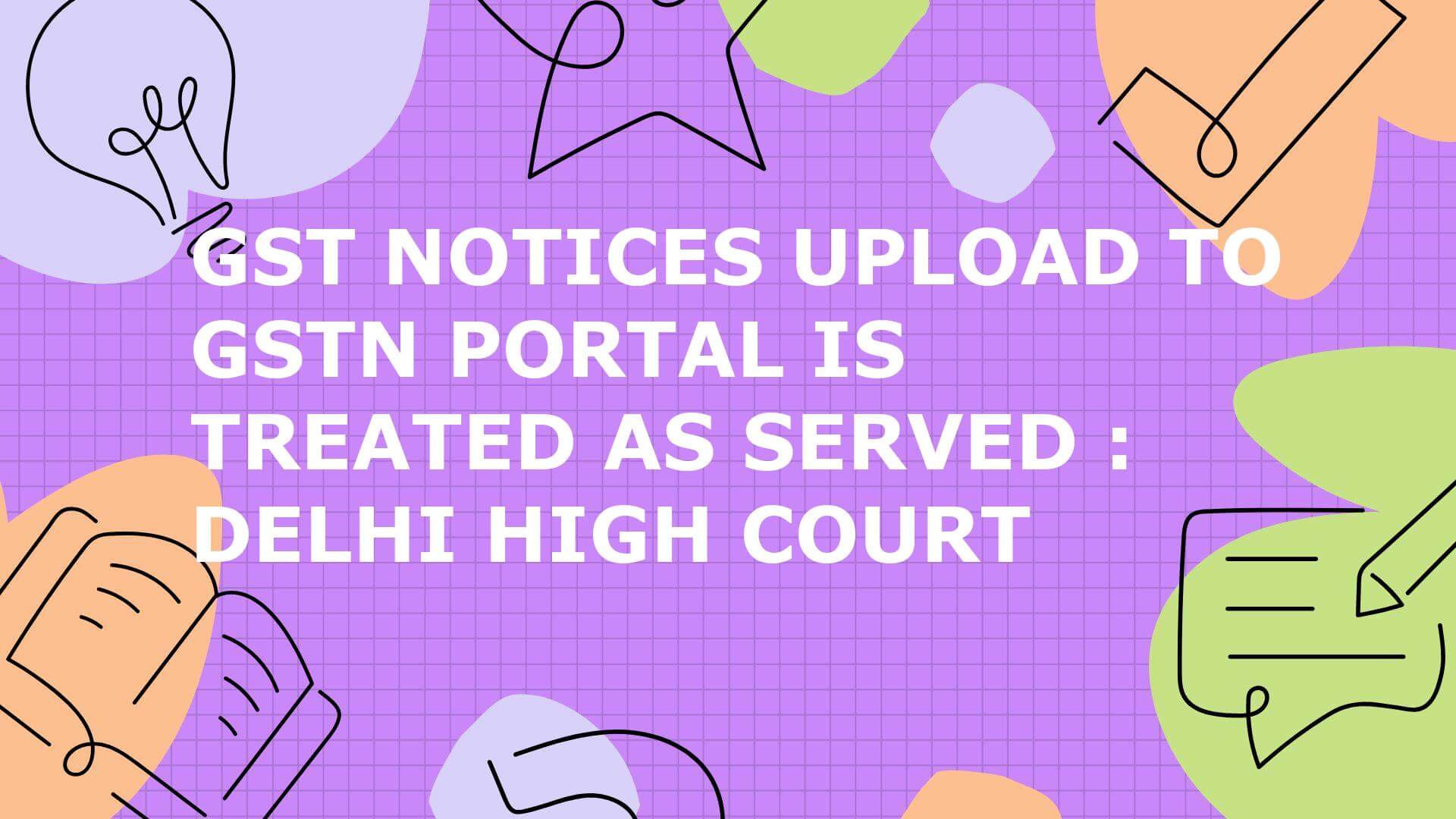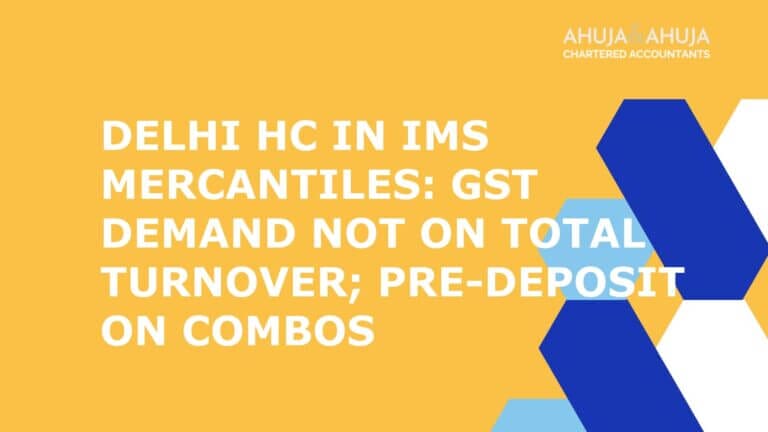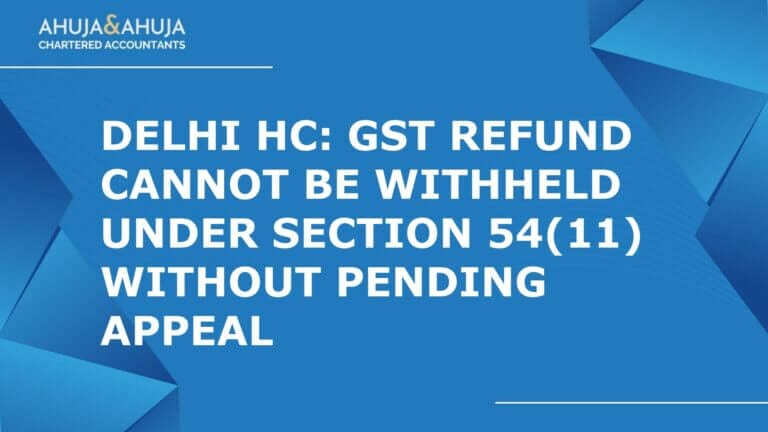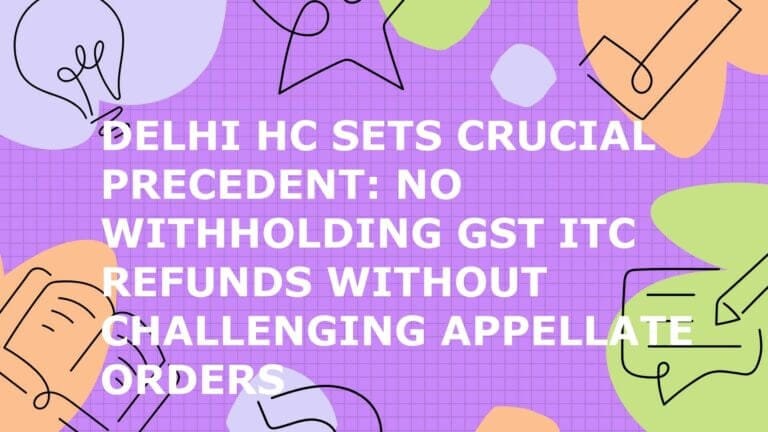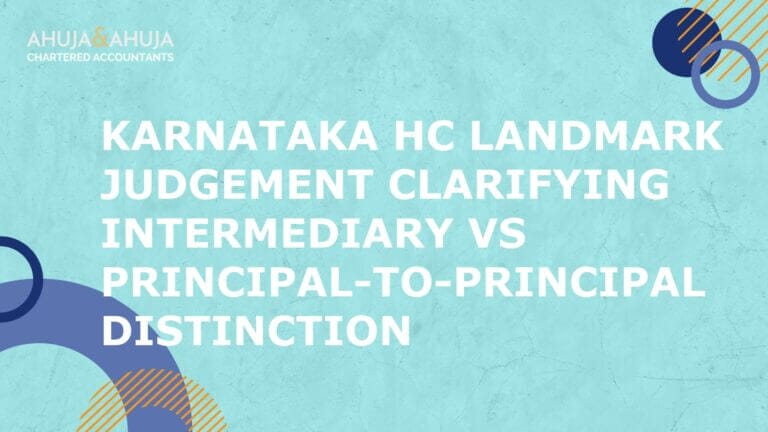GST Notices Upload to GSTN Portal is Treated as Served : Delhi High Court
The digital transformation of tax administration in India has been nothing short of dramatic. With GST compliance now almost entirely online, the way government communicates with taxpayers has shifted from paper and post to portals and push notifications. Against this backdrop, the recent Delhi High Court decision in Sandeep Garg v. Sales Tax Officer has set a new benchmark for what counts as “service” of a GST notice. For GST-registered businesses, this isn’t just a legal technicality—it’s a wake-up call that digital diligence is now a non-negotiable part of GST compliance.
This article unpacks the Delhi High Court’s judgment, explores its practical implications, and offers a roadmap for GST suppliers to avoid costly missteps in the new era of digital tax communication.
The Case in Focus: Sandeep Garg v. Sales Tax Officer
Let’s start with the facts. Sandeep Garg, proprietor of M/s Aares Spring Industries, found himself on the receiving end of a GST demand order totaling over ?9 lakh. The core of his grievance? He claimed he never received the Show Cause Notice (SCN) that triggered the proceedings. According to Garg, the notice was uploaded to the “additional notices and orders” tab on the GSTN portal, not the main “notices and orders” section, and thus wasn’t properly served.
Here’s how the events unfolded:
- 26 December 2023: The Sales Tax Officer issues a Show Cause Notice to Garg’s firm.
- 16 January 2024: The GSTN portal undergoes a structural change, affecting how notices are displayed.
- 9 February 2024: A reminder notice is uploaded, visible on the portal.
- No response: Garg’s accountant claims the portal was not functioning, so no reply is filed.
- 16 April 2024: The department passes an ex parte order, raising a demand.
- Writ petition: Garg challenges the order in the Delhi High Court, arguing lack of proper service.
The stakes were high—not just for Garg, but for every GST-registered business relying on digital communication for GST litigation services.
Dissecting the Judgment: Legal Issues and Judicial Reasoning
A. The Heart of the Dispute: What Counts as Service?
At the center of the case was a deceptively simple question: Does uploading a notice to the GSTN portal—regardless of which tab it appears under—constitute valid legal service to the taxpayer? Garg’s team argued that unless the notice appears in the “notices and orders” tab, it can’t be considered properly served. They also raised the issue of portal malfunction, suggesting that technical glitches prevented timely access.
B. The Arguments: Two Sides of the Digital Divide
Petitioner’s Stand
The notice was not in the expected portal location, so it was missed.
The accountant responsible for compliance couldn’t access the portal due to technical issues.
The department should have ensured proper, accessible service.
Respondent’s Reply
The reminder notice was clearly visible and accessible on the portal.
Automated emails and SMSs are sent whenever a notice is uploaded, providing additional alerts.
The onus is on the taxpayer to monitor the portal and respond.
C. The Court’s Reasoning: Digital Diligence is the New Norm
The Delhi High Court took a pragmatic approach. It noted that the reminder notice was indeed visible on the portal as of 9 February 2024, and that no reply was filed by the petitioner. The Court was unpersuaded by the argument that the portal’s structure or the specific tab used for uploading the notice made a material difference. In the digital age, the Court reasoned, taxpayers must exercise diligence in monitoring all relevant sections of the GSTN portal.
On the claim of portal malfunction, the Court looked for evidence—error logs, screenshots, or IT tickets—but found none. The burden, it held, lies with the taxpayer to demonstrate genuine technical barriers, not just make assertions.
Automated emails and SMSs, while helpful, were treated as supplementary. The primary mode of service, the Court clarified, is the portal upload itself.
D. Judicial Directions: The Road to Appeal
Recognizing the practical impact on the taxpayer, the Court allowed Garg to file an appeal under Section 107 of the CGST Act. Importantly, it relaxed the limitation period, directing that the appeal should be heard on merits if filed within 30 days, provided the required pre-deposit is made.
What This Means for GST Suppliers
The Delhi High Court’s judgment isn’t just a one-off decision—it’s a signal flare for every GST-registered business. The message is clear: if a notice is uploaded to the GSTN portal, it’s considered legally served, regardless of which tab it appears under or whether you received an email or SMS alert. This shift places a new burden of vigilance on taxpayers, fundamentally altering the compliance landscape.
1. Portal Upload = Legal Service
After this ruling, the act of uploading a notice to the GSTN portal—whether under “notices and orders” or “additional notices and orders”—is enough to satisfy the legal requirement of service. The Court’s logic is rooted in the digital-first design of GST compliance. If you’re registered under GST, you’re expected to be digitally literate and proactive.
2. Ignoring the Portal? The Risks Are Real
Failing to check the GSTN portal regularly can have serious consequences. If you miss a notice, you risk ex parte orders, tax demands, and the loss of your right to be heard. The Court made it clear: the department cannot be blamed for a taxpayer’s lack of diligence. The onus is now squarely on businesses to monitor their digital communications.
3. Diligence: Whose Responsibility Is It?
The judgment decisively shifts the burden of diligence to the taxpayer. While the department does send automated emails and SMSs, these are considered supplementary. The primary responsibility is yours—to log in, check all relevant tabs, and respond promptly.
Compliance and Risk Management: Practical Steps for GST Suppliers
So, how can businesses adapt to this new reality? Here’s a practical roadmap to safeguard your interests and stay ahead of compliance risks.
A. Monitoring and Documentation
Regular Portal Checks:
Set a fixed schedule—ideally daily, but at least every 2-3 days—to log into the GSTN portal. Don’t just glance at the main dashboard; systematically check all sections, including “notices and orders” and “additional notices and orders.”Internal Logging:
Maintain a digital logbook or spreadsheet recording each portal access, the sections checked, and any downloads made. Include timestamps and the name of the person responsible. This creates an audit trail that can be invaluable if you ever need to prove diligence.Handling Technical Glitches:
If you encounter portal issues, document everything. Take screenshots, save error messages, and raise IT tickets with the GSTN helpdesk. Preserve all correspondence—these records can be crucial if you need to contest a notice on the grounds of non-accessibility.
B. Optimising Notification Systems
Don’t Rely Solely on Emails/SMSs:
Treat automated alerts as helpful reminders, not your primary compliance tool. They can fail or be delayed. The portal itself is the official source.Train Your Team:
Ensure your accountants and compliance staff are trained to check the portal methodically. Use checklists and standard operating procedures (SOPs) to divide responsibilities and avoid lapses.Consider Automation:
Explore third-party tools or software that can monitor the GSTN portal and alert you to new uploads. Weigh the costs against the potential risk of missing a notice—often, the investment is justified.
C. Dealing with Unusual Notice Placement
Vigilance Across All Tabs:
Notices may appear in less-monitored sections. Make it a habit to check every relevant tab. If you find a notice in an unexpected location, act immediately—don’t assume it’s a mistake.Seek Support When Needed:
If you’re unsure about a notice’s placement or authenticity, consult your legal or GST consultancy services advisors promptly.
D. Appeal and Defense Procedures
Know the Appeal Process:
If you believe a notice was not properly served, Section 107 of the CGST Act allows you to appeal. File within 30 days, make the required pre-deposit, and ensure your appeal is supported by robust documentation.Preserve Evidence:
Keep records of portal downtime, screenshots of errors, and all communication with the GSTN helpdesk. These can support your case if you need to contest the validity of service.Defensive Strategies:
In your appeal, focus on concrete evidence—logs, error reports, and documented attempts to access the portal. Mere assertions won’t suffice.
Legal and Policy Perspectives: The Road Ahead
1. Precedential Value
This judgment is likely to influence how other courts interpret digital service of notices under GST and potentially other tax laws. The principle is clear: digital uploads, if accessible, are valid service.
2. Impact on Future Disputes
Expect more litigation around what constitutes “reasonable access” to digital portals and the sufficiency of supplementary notifications. The burden of proof will increasingly fall on taxpayers to show genuine barriers to access.
3. GSTN Portal Reforms
This case may prompt the GSTN to improve user experience, notification systems, and error reporting mechanisms. Policymakers could consider clearer guidelines on notice placement and more robust support for technical grievances.
The Takeaway: Digital Compliance as the New Legal Standard
The Delhi High Court’s ruling in Sandeep Garg v. Sales Tax Officer is more than a procedural clarification—it’s a paradigm shift. The Court’s message is unmistakable: in the GST regime, digital communication is not just a convenience, but a legal norm. For GST suppliers, this means that the days of relying on physical notices or waiting for email reminders are over. The GSTN portal is now the definitive channel for all official communication, and your vigilance—or lack thereof—can make or break your compliance standing.
Key Judicial Message
The Court has drawn a clear line: uploading a notice to the GSTN portal, regardless of the tab or section, is sufficient legal service. Supplementary notifications like emails and SMSs are helpful, but not essential. The responsibility to monitor the portal is now firmly on the taxpayer’s shoulders.
How GST Suppliers Should Adapt
Embrace Digital Diligence:
Make regular portal checks a non-negotiable part of your compliance routine. Assign clear responsibility within your team, and use checklists or digital tools to ensure no section is overlooked.Document Everything:
Maintain meticulous records of portal access, downloads, and any technical issues encountered. This documentation is your first line of defense if you ever need to contest a notice or demonstrate your compliance efforts.Invest in Training and Tools:
Equip your accountants and compliance staff with the knowledge and resources to navigate the GSTN portal efficiently. Consider automation solutions if your notice volume or risk profile justifies it.Act Promptly on All Notices:
Treat every notice—regardless of where it appears on the portal—as urgent. If you find a notice in an unexpected section, don’t delay. Seek clarification or legal advice immediately.Prepare for Appeals:
If you believe a notice was not properly served or you faced genuine technical barriers, be ready to appeal under Section 107 of the CGST Act. Support your case with concrete evidence, not just assertions.
Looking Forward: Staying Ahead in a Digital-First Compliance World
The GSTN portal will continue to evolve, and so will the expectations placed on taxpayers. As digital service of notices becomes the norm across tax and regulatory domains, businesses that build robust digital compliance systems will be best positioned to avoid disputes and penalties.
Staying ahead means not just reacting to legal developments, but anticipating them. Regularly review your compliance protocols, stay updated on judicial trends, and foster a culture of digital accountability within your organization.
Final Thought
The digital age rewards those who are proactive, not passive. For GST suppliers, the Delhi High Court’s judgment is both a warning and an opportunity: adapt your compliance practices now, and you’ll not only avoid pitfalls—you’ll set the standard for others to follow.
Disclaimer
The materials provided herein are solely for educational and informational purposes. No attorney/professional-client relationship is created when you access or use the site or the materials. The information presented on this site does not constitute legal or professional advice and should not be relied upon for such purposes or used as a substitute for professional or legal advice.

